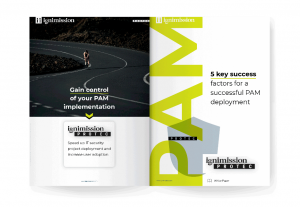Third key factor for a successful PAM project: Focus on user adoption
Last month we launched our very first white paper on how to have a successful PAM deployment. We have identified 5 key success factors to consider in the early stages of your project to ensure its success, the first step is Change Management and the second is setting KPIs. In today’s article, we’re focusing on the third step which is: focus on user adoption.

A successful PAM implementation will be the result of many people — depending on the size of your organization, potentially thousands upon thousands of people — providing the necessary data for the project’s completion. One useful framework for viewing this challenge is the concept of user adoption as if you were an app developer trying to increase engagement or a marketer trying to increase conversion rates. This approach focuses on the proverbial carrot instead of the stick, and it is likely to get you closer to your goals.
Persuading people to do something is yet another aspect of the dreaded office politics, but it doesn’t have to be uncomfortable. Many people react defensively when they are given a direct order: “Give me your data by the end of this week!”. Even more provocative could be an order with a threat attached to it: “Give me your data by the end of this week, or else!”. Even if you have the strong backing of senior management, these approaches should only be used after all other approaches have been exhausted. At this point, the old saying, “you catch more flies with honey than vinegar,” might come to mind.
The foundation of what we are suggesting can be found in design thinking, a problem-solving process described by the design firm, IDEO, as having a “human-centred core.” As IDEO explains, design thinking requires, “pulling together what’s desirable from a human point of view with what is technologically feasible and economically viable… It’s about embracing simple mindset shifts and tackling problems from a new direction.”
Nobody knows better than you what is technologically feasible and economically viable in your organization. The key to employing design thinking and seeing your project as one of user adoption is to be prepared to experiment and try different strategies in getting people to respond to your requests. First, don’t approach everyone at the same time with the same strategy. For example, send an email to one batch of users. If the response rate is poor, try another approach, such as a workshop or paper flyer. Test out your messages, too: it could be that appealing to organizational goals of safety and security could resonate more than appealing to personal benefits.
This human-centred mentality means keeping in mind the different situations of the various groups of your target audience. Obviously, cultural differences need to be considered. But beyond that, technical profiles might respond differently than non-technical profiles, and, for example, sales teams might respond differently than operations teams. At the heart of design thinking is empathy, an ability to put yourself in the shoes of the user and see things from their perspective, as opposed to viewing them as a problem in itself to be solved.
Obviously, not even the best diplomats in the world are capable of winning everyone over to their side, so you are bound to run into some resistance. By employing design thinking, empathy, and a perspective of user adoption, though, it is possible to limit the frequency and severity of these negative incidents. In user experience design (UX), when it is clear that some users want a certain feature, that feature is usually prioritized. Likewise, when it is clear that some users are more likely to be cooperative when given a certain message or approach, don’t hesitate to make things easier for them. It might seem like more work in the short term, but in the long term, it will pay off.
In the context of a PAM project, one of the keys to encouraging user adoption will be to provide them with the right communication tools and especially dashboards with KPIs specific to each population.
To read about the rest of our steps to obtain a successful PAM deployment project download our white paper here: https://ignimission.ac-page.com/en-ignimission-protec-white-paper



